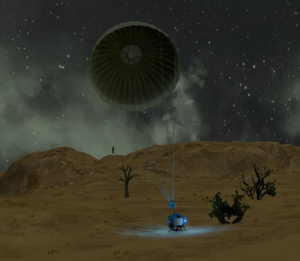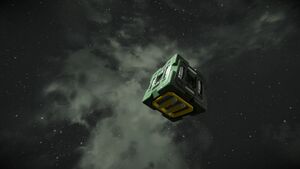Parachute Hatch
| Parachute Hatch | |
|---|---|
| Category: | Functional |
| Function: | a parachute for atmospheric landings |
| Fits small grid | |
| Mass: | 84.2 kg |
| PCU: | 50 |
| Size: | 1x1x1 |
| Time to Build: | 10 sec |
| Fits large grid | |
| Mass: | 472.4 kg |
| PCU: | 50 |
| Size: | 1x1x1 |
| Time to Build: | 22 sec |
| Data Controls: | [edit] [purge] (?) |
The Parachute Hatch is a functional block used to gradually slow the trajectory of a mobile grid to a safe velocity.
Hatches must be reloaded with ![]() Canvas before use.
Canvas before use.
Usage
Compared to slowing down manually using atmospheric or hydrogen braking thrusters, parachutes only use a fraction of the power/hydrogen. At the same time, deployed parachutes prevent you from being able to steer or adjust your heading.
Typically you install Parachute Hatches on shuttles, rescue pods, or cargo drops that land vertically on atmospheric planets. Also a car racing can deploy a horizontal drogue chute to perform braking manoeuvres that are faster than any other means of deceleration.
Conditions
The parachute behaviour can be a bit counter-intuitive since the actual atmospheric pressure is ignored. The auto deployment conditions are simply that parachutes work on planets with atmosphere and planetary gravity. This means:
- If you create an artificial airtight and pressurized room with artificial gravity on an asteroid, the Parachute will not deploy.
- If you create an artificial airtight and depressurized room on a planet, the Parachute will deploy.
How to open the parachute
Typically, you group your parachutes, and define an auto-deploy height for them. Then assign the group's Open action, as well as the group's Auto Deploy On/Off toggle to toolbar slots to be able to trigger them.
The Parachute Hatch comes with several settings in its Control Panel Screen:
- Open - Click this button to manually deploy the parachute (or parachute group).
- Closed - Click this button to manually cut the parachutes.
- Auto deploy - Choose whether the parachute should auto deploy at a certain height.
- Auto deploy height -- Move the slider to define a height in metres above "sea level".
Conditions for the parachute hatch to open:
- Must be in dense atmosphere
- Must be loaded with one set of canvas
- Must be in natural gravity
In thin atmospheres, the parachute looks oblong, that means it does not have its full effect.
How many are "one set" of canvas?
Deploying the Parachute Hatch uses up one set of cavas.
- On small grid each hatch uses up 1 piece of canvas
- On large grid each hatch uses up five pieces of canvas.
What if blocks are in the way of the parachute?
When the hatch opens, the parachute unfurls. It does not matter whether the hatch doors are covered by other blocks, the parachute will deploy even through the hull.
How to reload Canvas
Every Parachute Hatch, whether large grid or small grid, has only one conveyor door which is the only place where canvas can be inserted. The inventory holds 8 litres on small grid and 40L on large grid. The inventory can hold nothing but one set of ![]() Canvas items.
Canvas items.
- On small grid, one set is one canvas.
- On large grid, one set is five canvases.
You cannot pre-load several sets of canvas in advance. Attaching the blocks to your conveyor system is recommended to be able to reload all hatches quickly and automatically. Otherwise, you must keep the ports accessible for manual reload — and face the risk of forgetting to reload it (and crashing).
What is the auto-deploy height?
The parachute auto deploy height is defined above global sea level. Note that the display in your cockpit is height above local ground level!
Also make sure to avoid mountain tops and high plains: When parachutes auto-deploy in a thin atmosphere above the highest mountain, they may not be able to slow you down enough before you reach the ground.
How to get rid of the parachute
Parachutes despawn when inertia and velocity are 0 m/sec. When the ship rests on the planet surface, the parachutes cut automatically.
Careful:
- If you accidentally slow down, maybe because your inertial dampers engaged the thrusters, the parachute will auto-cut and likely be expended earlier than expected.
- If you cannot come to a rest, maybe because your ship is slowly sliding down a cliff, the parachutes will remain open, and prevent you from actively steering or accelerating.
- It’s safer to disable auto-deploy when there’s a chance of abrupt velocity changes ahead -- for example, before a ship is copied and pasted using Creative tools in a Survival game, or when sliding down the side of a mountain.
Manually closing deployed parachutes does not return the canvas, it is used up!
"But I tested it in Creative Mode..."
Parachute Hatches work differently in Survival Mode and Creative Mode:
- In creative mode, Parachute Hatches can deploy and cut (Open and Close button) an infinite number of times.
- In survival mode, Parachute Hatches will only deploy if a set of
 Canvas has been loaded in the Parachute Hatches' inventory; each time the hatch is deployed, one set of canvas items is consumed.
Canvas has been loaded in the Parachute Hatches' inventory; each time the hatch is deployed, one set of canvas items is consumed.
Even if your ship lands well during a test in Creative Mode, you still need to verify whether Canvas is conveyored properly in Survival Mode.
Damage
The Parachute Hatch can be damaged and become non-functional. But after deployment, the parachute itself is impervious to damage, shots, or collisions.
Inventory
The inventory holds 8 litres on small grid and 40L on large grid. The inventory can hold nothing but one size-dependent set of ![]() Canvas items.
Canvas items.
Construction
The Parachute Hatch exists for large and small grids and is 1x1x1 blocks in size. It has mount points on all sides and it has one conveyor port on its bottom face. The act of opening and closing parachutes requires power; having them open or closed does not require power.
For the parachutes' functionality, it makes no difference which way up the block is rotated. The parachute will open "upwards" even if other blocks appear to be in the way. Rotation is only relevant for how you want to access the conveyor port. The Parachute Hatch has only one conveyor port, which is the only place where canvas can be inserted.
The hatches' position on the ship is, however, critical for a smooth landing. If not placed symmetrically around the Center of Mass, parachutes can tilt your ship and cause an uncontrolled (albeit slowed) landing. The parachutes' location on the ship body relative to its Center of Mass (CoM) affect how the vessel lands: If more parachutes are on one side of the CoM than the other, one end will be pulled up and the opposing end will droop down, which results in the ship not landing horizontally on its landing gear, but possibly hit the ground sideways or get stuck on blocks that could get damaged. To see your centre of gravity, enable the visualisation on the ship's Info Screen.
Additionally, you need to build a suitable number of Parachute Hatch blocks for the mass you want to slow down. One small grid Parachute Hatch can slow about 10,000 kg of grid mass. For large-grid Hatches it's about 100,000 kg. The general rule of thumb for safe landing speeds is < 8 meters per second for small ships and even less for massive large grid ships.
Recipe
| Component | Large Ship/Station Required | Large Ship/Station Optional | Small Ship Required | Small Ship Optional |
|---|---|---|---|---|
| 5 | 4 | 1 | 1 | |
| 5 | — | 1 | — | |
| 3 | — | 1 | — | |
| 25 | — | 2 | — | |
| 2 | — | 1 | — | |


